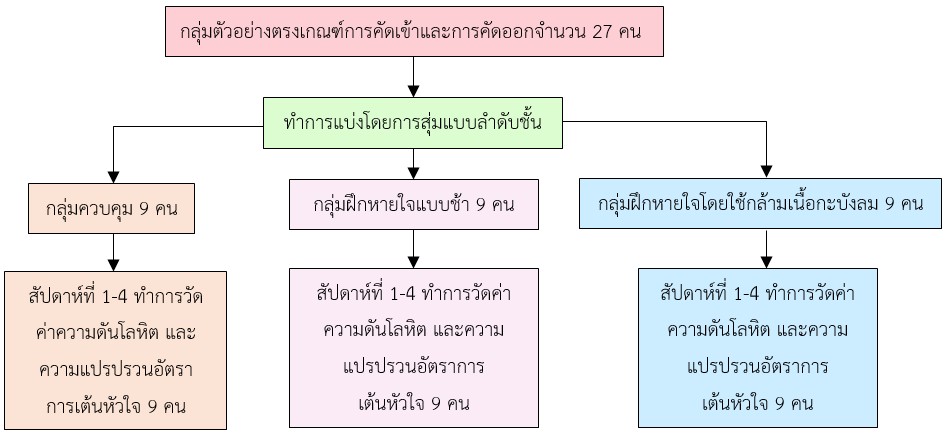การเปรียบเทียบการลดลงของความดันโลหิตและค่าความแปรปรวนของอัตราการเต้นหัวใจ ระหว่างการฝึกหายใจแบบช้าและการหายใจโดยใช้กล้ามเนื้อกระบังลมในผู้ชายอายุ 18-25 ปีที่มีภาวะเสี่ยงต่อภาวะความดันโลหิตสูง
คำสำคัญ:
ภาวะเสี่ยงความดันโลหิตสูง, การหายใจแบบช้า, การหายใจโดยใช้กล้ามเนื้อกะบังลม, ความแปรปรวนอัตราการเต้นหัวใจบทคัดย่อ
การวิจัยเชิงทดลองแบบสุ่มที่มีการควบคุมนี้เพื่อศึกษาผลการเปลี่ยนแปลงของค่าความดันโลหิต และค่าความแปรปรวนของอัตราการเต้นของหัวใจ ภายหลังการฝึกหายใจแบบใช้กล้ามเนื้อกะบังลม และการฝึกหายใจแบบช้า กลุ่มตัวอย่าง คือ ผู้ชายอายุ 18-25 ปี ที่มีภาวะเสี่ยงต่อภาวะความดันโลหิตสูง จำนวน 27 คน ทำการสุ่มตัวอย่างแบบลำดับชั้น แบ่งเป็น 3 กลุ่มให้เท่ากัน ได้แก่ กลุ่มควบคุม (Control), กลุ่มหายใจแบบช้า (Slow Breathing Exercise (SBE)) และกลุ่มหายใจโดยใช้กะบังลม (Diaphragmatic Breathing Exercise (DBE)) เก็บรวบรวมข้อมูลเป็นระยะเวลา 4 สัปดาห์ เครื่องมือที่ใช้ในการวิจัย ได้แก่ การประเมินค่าที่เปลี่ยนแปลงของความดันโลหิตโดย OMRON (Blood Pressure Monitor) และการเปลี่ยนแปลงของค่าความแปรปรวนของอัตราการเต้นหัวใจ (Heart Rate Variability (HRV)) โดย Polar Team 2 วิเคราะห์ข้อมูลโดยใช้สถิติ Two-way Mixed ANOVA
ผลการวิจัยพบว่า ทั้งการหายใจแบบช้าและการหายใจโดยใช้กะบังลมช่วยลด Systolic Blood Pressure (SBP) และ Pulse Pressure (PP) ตั้งแต่สัปดาห์ที่ 2, 3 และ 4 โดยการหายใจโดยใช้กล้ามเนื้อกะบังลมลด SBP (p-value = 0.041, 0.047, 0.018) และ PP (p-value = 0.006, 0.003, 0.043) อย่างมีนัยสำคัญทางสถิติส่วนการหายใจแบบช้าลด SBP (p-value = 0.018, 0.009, 0.004) และ PP (p-value = 0.003, 0.001, 0.001) อย่างมีนัยสำคัญทางสถิติ สรุปได้ว่าการฝึกหายใจเป็นเวลา 2 สัปดาห์ขึ้นไปสามารถลดความดันโลหิตได้โดยไม่ส่งผลต่อ Heart Rate Variability ในผู้ชายอายุ 18-25 ปีที่มีความเสี่ยงต่อภาวะความดันโลหิตสูง
เอกสารอ้างอิง
กองโรคไม่ติดต่อ. (2566). จำนวนและอัตราตายด้วย 5 โรคไม่ติดต่อ (ปี 2560-2564). สืบค้นเมื่อ 12 ธันวาคม 2566 จาก http://www.thaincd.com/2016/mission/documents-detail.php?id=14480&tid=32&gid=1-020.
ชุติพงษ์ เติมเพ็ชร, สุวัฒน์ จิตรดำรงค์, มีน พรหมมนตรี, สุวิรา วงษ์ชื่น, อรอุมา ถานทองดี และประภาวดี ภิรมย์พล. (2559). การศึกษานำร่อง: เทคนิคการฝึกหายใจแบบใช้กล้ามเนื้อกระบังลม มีประสิทธิภาพในการลดความดันซีสโตลิก เมื่อเปรียบเทียบกับเทคนิคการหายใจแบบช้า ในกลุ่มเสี่ยงต่อความดันโลหิตสูงวัยหนุ่มสาว. วารสารกายภาพบำบัด, 38(2), 81-92.
Adhana, R., Gupta, R., Dvivedii, J., & Ahmad, S. (2013). The influence of the 2:1 yogic breathing technique on essential hypertension. Indian Journal of Physiology and Pharmacology, 57(1), 38-44.
Aekplakorn, W., et al. (2008). Prevalence and management of prehypertension and hypertension by geographic regions of Thailand: The Third National Health Examination Survey, 2004. Journal of Hypertension, 26(2), 191-198. https://doi.org/10.1097/HJH.0b013e3282f09f57
Al-Majed, H. T., & Sadek, A. A. (2012). Pre-hypertension and hypertension in college students in Kuwait: A neglected issue. Journal of Family & Community Medicine, 19(2), 105-112. https://doi.org/10.4103/2230-8229.98296
Ali, N., Mohanto, N. C., Nurunnabi, S. M., Haque, T., & Islam, F. (2022). Prevalence and risk factors of general and abdominal obesity and hypertension in rural and urban residents in Bangladesh: A cross-sectional study. BMC Public Health, 22(1), 1707. https://doi.org/10.1186/s12889-022-14087-8
Anderson, D. E., McNeely, J. D., & Windham, B. G. (2009). Device-guided slow-breathing effects on end-tidal CO(2) and heart-rate variability. Psychology, Health & Medicine, 14(6), 667-679. https://doi.org/10.1080/13548500903322791
Bernardi, L., et al. (2002). Slow breathing increases arterial baroreflex sensitivity in patients with chronic heart failure. Circulation, 105(2), 143-145. https://doi.org/10.1161/hc0202.103311
Bundy, J. D., et al. (2017). Systolic blood pressure reduction and risk of cardiovascular disease and mortality: A Systematic review and network meta-analysis. JAMA Cardiology, 2(7), 775-781. https://doi.org/10.1001/jamacardio.2017.1421
Charoendee, K., Sriratanaban, J., Aekplakorn, W., & Hanvoravongchai, P. (2018). Assessment of population coverage of hypertension screening in Thailand based on the effective coverage framework. BMC Health Services Research, 18(1), 208. https://doi.org/10.1186/s12913-018-2996-y
De Venecia, T., Lu, M., & Figueredo, V. M. (2016). Hypertension in young adults. Postgraduate Medicine, 128(2), 201-207. https://doi.org/10.1080/00325481.2016.1147927
Faul, F., Erdfelder, E., Lang, A. G., & Buchner, A. (2007). G*Power 3: A flexible statistical power analysis program for the social, behavioral, and biomedical sciences. Behavior Research Methods, 39(2), 175-191. https://doi.org/10.3758/bf03193146
Flack, J. M., & Adekola, B. (2020). Blood pressure and the new ACC/AHA hypertension guidelines. Trends in Cardiovascular Medicine, 30(3), 160-164. https://doi.org/10.1016/j.tcm.2019.05.003
Fuchs, F. D., & Whelton, P. K. (2020). High blood pressure and cardiovascular disease. Hypertension (Dallas, Tex. : 1979), 75(2), 285-292. https://doi.org/10.1161/HYPERTENSIONAHA.119.14240
Hagins, M., Rundle, A., Consedine, N. S., & Khalsa, S. B. (2014). A randomized controlled trial comparing the effects of yoga with an active control on ambulatory blood pressure in individuals with prehypertension and stage 1 hypertension. Journal of Clinical Hypertension (Greenwich, Conn.), 16(1), 54-62. https://doi.org/10.1111/jch.12244
Huikuri, H. V., et al. (1996). Heart rate variability in systemic hypertension. The American journal of cardiology, 77(12), 1073-1077. https://doi.org/10.1016/s0002-9149(96)00135-x
Joseph, C. N., et al. (2005). Slow breathing improves arterial baroreflex sensitivity and decreases blood pressure in essential hypertension. Hypertension (Dallas, Tex. : 1979), 46(4), 714-718. https://doi.org/10.1161/01.HYP.0000179581.68566.7d
Lin, G., et al. (2012). Heart rate variability biofeedback decreases blood pressure in prehypertensive subjects by improving autonomic function and baroreflex. Journal of Alternative and Complementary Medicine (New York, N.Y.), 18(2), 143-152. https://doi.org/10.1089/acm.2010.0607
Lin, I. M., Tai, L. Y., & Fan, S. Y. (2014). Breathing at a rate of 5.5 breaths per minute with equal inhalation-to-exhalation ratio increases heart rate variability. International Journal of Psychophysiology : Official Journal of the International Organization of Psychophysiology, 91(3), 206-211. https://doi.org/10.1016/j.ijpsycho.2013.12.006
Liu, J., et al. (2020). Association between pulse pressure and carotid intima-media thickness among low-income adults aged 45 years and older: A population-based cross-sectional study in rural China. Frontiers in Cardiovascular Medicine, 7, 547365. https://doi.org/10.3389/fcvm.2020.547365
Ma, X., et al. (2017). The effect of diaphragmatic breathing on attention, negative affect and stress in healthy adults. Frontiers in psychology, 8, 874. https://doi.org/10.3389/fpsyg.2017.00874
Manios, E., et al. (2009). Impact of prehypertension on common carotid artery intima-media thickness and left ventricular mass. Stroke, 40(4), 1515-1518. https://doi.org/10.1161/STROKEAHA.108.528174
World Health Organization. (2013). Global action plan for the prevention and control of NCDs 2013-2020. Retrieved December 12, 2023 from http://www.who.int/nmh/publications/ncd-action-plan/en/.
Pal, G. K., Velkumary, S., & Madanmohan (2004). Effect of short-term practice of breathing exercises on autonomic functions in normal human volunteers. The Indian Journal of Medical Research, 120(2), 115-121.
Peltzer, K., et al. (2017). Prehypertension and psychosocial risk factors among university students in ASEAN countries. BMC Cardiovascular Disorders, 17(1), 230. https://doi.org/10.1186/s12872-017-0666-3
Pongwecharak, J., & Treeranurat, T. (2010). Screening for pre-hypertension and elevated cardiovascular risk factors in a Thai community pharmacy. Pharmacy World & Science : PWS, 32(3), 329-333. https://doi.org/10.1007/s11096-010-9373-1
Rafan, S. N., Zakaria, R., Ismail, S. B., & Muhamad, R. (2018). Prevalence of prehypertension and its associated factors among adults visiting outpatient clinic in Northeast Malaysia. Journal of Taibah University Medical Sciences, 13(5), 459-464. https://doi.org/10.1016/j.jtumed.2018.06.005
Sansanayudh, N., Luvira, V., Woracharoensri, N., Phulsuksombati, D., & Sripen, R. (2009). Prevalence of prehypertensive state and other cardiovascular risk factors in the First Infantry Regiment, the King's own bodyguard. Journal of the Medical Association of Thailand, 92 Suppl 1, S28-S38.
Shaffer, F., & Ginsberg, J. P. (2017). An overview of heart rate variability metrics and norms. Frontiers in Public Health, 5, 258. https://doi.org/10.3389/fpubh.2017.00258
Sikora, M., et al. (2024). Influence of the breathing pattern on the pulmonary function of endurance-trained athletes. Scientific Report, 14(1), 1113. https://doi.org/10.1038/s41598-024-51758-5
Singh, J. P., Larson, M. G., Tsuji, H., Evans, J. C., O'Donnell, C. J., & Levy, D. (1998). Reduced heart rate variability and new-onset hypertension: insights into pathogenesis of hypertension: The Framingham Heart Study. Hypertension (Dallas, Tex. : 1979), 32(2), 293-297. https://doi.org/10.1161/01.hyp.32.2.293
Terathongkum, S., & Pickler, R. H. (2004). Relationships among heart rate variability, hypertension, and relaxation techniques. Journal of Vascular Nursing : Official Publication of the Society for Peripheral Vascular Nursing, 22(3), 78-84. https://doi.org/10.1016/j.jvn.2004.06.003
Tremongkontip, S., Kiettinun, S., Pawa, Kummal K. P., & Pattaraarchachai, J. (2012). Prevalence and risk factors of prehypertensive people in the community. Thammasat Medical Journal 12(4), 688-697.
Vanderlei, L. C., Pastre, C. M., Hoshi, R. A., Carvalho, T. D., & Godoy, M. F. (2009). Basic notions of heart rate variability and its clinical applicability. Revista brasileira de Cirurgia Cardiovascular : Orgao oficial da Sociedade Brasileira de Cirurgia Cardiovascular, 24(2), 205-217. https://doi.org/10.1590/s0102-76382009000200018
Wang, S. et al. (2010). Effect of slow abdominal breathing combined with biofeedback on blood pressure and heart rate variability in prehypertension. Journal of Alternative and Complementary Medicine (New York, N.Y.), 16(10), 1039-1045. https://doi.org/10.1089/acm.2009.0577
Yau, K. K., & Loke, A. Y. (2021). Effects of diaphragmatic deep breathing exercises on prehypertensive or hypertensive adults: A literature review. Complementary Therapies in Clinical Practice, 43, 101315. https://doi.org/10.1016/j.ctcp.2021.101315

ดาวน์โหลด
เผยแพร่แล้ว
รูปแบบการอ้างอิง
ฉบับ
ประเภทบทความ
สัญญาอนุญาต
ลิขสิทธิ์ (c) 2024 วารสารวิจัยการพยาบาลและการสาธารณสุข

อนุญาตภายใต้เงื่อนไข Creative Commons Attribution-NonCommercial-NoDerivatives 4.0 International License.
1. บทความหรือข้อคิดเห็นใด ๆ ที่ปรากฏในวารสารวิจัยการพยาบาลและการสาธารณสุข ที่เป็นวรรณกรรมของผู้เขียน บรรณาธิการไม่จำเป็นต้องเห็นด้วย
2. บทความที่ได้รับการตีพิมพ์ถือเป็นลิขสิทธิ์ของ วารสารวิจัยการพยาบาลและการสาธารณสุข








